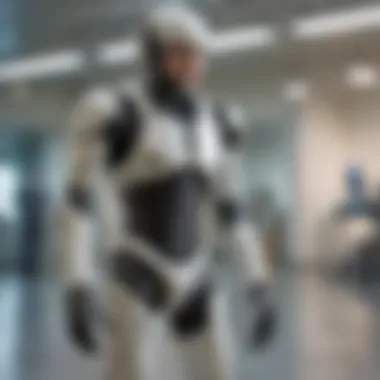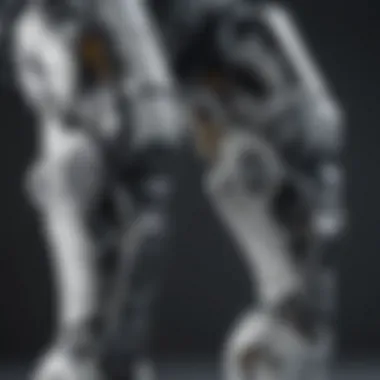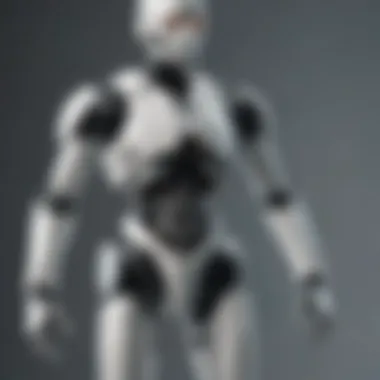Innovative Walking Exoskeletons: Trends and Impact


Article Overview
Purpose of the Article
This article seeks to explore the innovative field of walking exoskeletons which have gained significant attention for their potential to assist those with mobility impairments. The technology behind these devices is not just fascinating from an engineering perspective, but it also has profound implications for the users it serves. By addressing various aspects—from technical advancements to user experience—this article aims to provide a comprehensive understanding of how walking exoskeletons can reshape mobility. Specifically, it will look at applications in rehabilitation, industry, and the critical ethical considerations involved in their deployment.
Relevance to Multiple Disciplines
Walking exoskeletons are a convergence of multiple fields including robotics, rehabilitation science, and bioethics. This interconnectedness means that research and development are not confined to a single discipline. Medical professionals, engineers, and ethicists must collaborate to create devices that are not only effective but also considerate of user needs and societal impacts. The interplay of technology, human factors, and ethical implications makes this topic relevant across various academic and professional spheres, making it essential for students and researchers alike.
Research Background
Historical Context
The concept of powered exoskeletons can be traced back to the mid-20th century, with early prototypes designed primarily for military use. Over the decades, research has evolved, transforming these devices from clunky machinery to sophisticated tools that can significantly enhance mobility. Recent years have seen a surge in academic research and practical applications, fueled by advancements in robotics and materials science. As the technology matures, it becomes increasingly applicable in healthcare settings, particularly for rehabilitation and support in physical therapy.
Key Concepts and Definitions
When discussing walking exoskeletons, certain terms need clarification:
- Exoskeleton: A wearable device designed to support the user’s body, often assisting in movement or enhancing strength.
- Mobility Impairments: These refer to conditions that limit a person’s ability to move or walk, including but not limited to paralysis, muscular dystrophy, and severe injuries.
- Assistive Technology: Any device that helps individuals with disabilities perform functions that might otherwise be difficult or impossible.
Understanding these key concepts is essential for grasping the broader discussions around the technology and its applications. Walking exoskeletons not only represent engineering feats but also pivotal tools in improving quality of life for many individuals.
Walking exoskeletons have the potential to make a lasting impact on society by addressing the challenges faced by individuals with mobility deficiencies.
Walking exoskeletons have the potential to make a lasting impact on society by addressing the challenges faced by individuals with mobility deficiencies.
Foreword to Walking Exoskeletons
Walking exoskeletons are innovative devices that assist individuals facing mobility challenges. The significance of this technology is evident in their potential to enhance everyday life for many. These exoskeletons not only provide physical support but also serve as a bridge to greater independence. Their design integrates mechanics, sensors, and control systems to mimic human movement while aiding rehabilitation.
Definition and Concept
A walking exoskeleton is a wearable robotic suit that aids the movement of the user. It is often designed for people who suffer from conditions that limit their ability to walk, such as spinal cord injuries, neuromuscular diseases, or other disabilities. The primary goal is to restore mobility and improve the quality of life. There are different types of exoskeletons, some focus on rehabilitation while others are for industrial use.
The concept revolves around combining robotics and biomechanics. By using motors and actuators, these devices replicate joint motions and support the user's weight. Control algorithms are essential. They ensure that the movements are synchronized with the user’s intentions.
Historical Background
The development of walking exoskeletons traces back several decades. Early designs emerged from military applications, aiming to enhance soldier performance. Over time, they shifted focus towards healthcare. The first notable advancements came in the late 20th century, with researchers working to create devices that could help people regain mobility.
In the early 2000s, prototypes like the ReWalk exoskeleton began trials. These pivotal moments laid the foundation for commercial products. As technology progressed, the integration of advanced materials and electronic systems became essential. Today, companies like Ekso Bionics and Lockheed Martin continue to push the boundaries.
Overall, walking exoskeletons represent a blend of engineering and human need. As research expands, so do their capabilities, promising transformative impacts on rehabilitation and mobility.
Technical Foundations
The technical foundations of walking exoskeletons are critical in understanding their development and functionality. These devices rely on a combination of engineering principles, robotics, and software systems. Grasping these foundations enables designers to innovate effectively and respond to the increasing needs of individuals who require mobility assistance.
Mechanics of Exoskeleton Design
The mechanics of exoskeleton design encompass the physical structure and engineering elements that provide support and mobility to users. This includes materials selection, load distribution, and joint articulation.
- Materials: Exoskeletons are often made from lightweight yet strong materials such as carbon fiber and aluminum. The goal is to minimize weight while maximizing strength and durability.
- Load distribution: It is essential to design this aspect to ensure the device bears weight evenly across the user's body. An appropriate load distribution prevents fatigue and enhances comfort during use.
- Joint articulation: The range of motion in exoskeletons must mimic natural human movement. Pivot points and actuators must be positioned precisely to achieve this, allowing for fluid and natural walking patterns.
Understanding these components is vital, as they directly influence user comfort and performance.
Sensor Technologies
Sensor technologies play an integral role in the functionality of walking exoskeletons. These devices incorporate various sensors that gather data about the user's movements, environment, and physiological state.
- Inertial Measurement Units (IMUs): These sensors track orientation, acceleration, and rotational motion. They provide critical data that helps the exoskeleton adapt in real time to the user's movements.
- Force sensors: These sensors measure the forces exerted by the user and the surroundings. They allow the exoskeleton to respond appropriately, ensuring stability and safety during movement.
- Pressure sensors: To enhance comfort and usability, pressure sensors ensure that the exoskeleton maintains proper contact without exerting excessive pressure on the user's body.
The integration of advanced sensor technologies is crucial for improving the responsiveness and adaptability of exoskeleton systems.
Control Systems
Control systems are the brains behind walking exoskeletons, governing their responses and actions based on sensor feedback. A well-developed control system is essential to facilitate seamless interaction between the user and the device.
There are different types of control strategies that can be employed:


- Open-loop control: This method does not rely on feedback from the user's movements. It functions based on predefined commands, which can limit adaptability in real-time scenario.
- Closed-loop control: In contrast, this system utilizes feedback from sensors to make adjustments during movement. It allows the exoskeleton to respond to changes in speed, terrain, and user intention.
- Adaptive control: This advanced approach combines the benefits of open and closed-loop systems. It continuously gathers data to refine its functioning over time, ensuring that the device evolves with the user's needs.
A sophisticated control system is vital in ensuring that walking exoskeletons operate safely and effectively, ultimately empowering individuals with enhanced mobility.
Applications of Walking Exoskeletons
The applications of walking exoskeletons signify a pivotal evolution in assisting individuals with mobility challenges. These devices integrate cutting-edge technology and novel designs to progress beyond traditional aids. The significance of exploring these applications lies not just in their technical aspects, but also in understanding how they can profoundly impact lives. This section examines three primary domains: healthcare and rehabilitation, industrial and military usage, and sports and performance enhancement. Each of these applications presents unique benefits and challenges that merit exploration.
Healthcare and Rehabilitation
Walking exoskeletons in healthcare offer transformational benefits for rehabilitation. Primarily, they facilitate recovery for individuals with spinal cord injuries or strokes. Rehabilitation programs increasingly incorporate these devices to enhance physical therapy outcomes. The exoskeleton allows patients to practice walking motions in a controlled environment, which is critical for retraining their muscles and improving cardiovascular health.
In addition, these technologies provide feedback on user movements, empowering therapists to develop tailored rehabilitation plans. This data-driven approach enhances the effectiveness of treatments, as therapists can make informed adjustments based on real-time monitoring of patient progress.
"The integration of exoskeletons in rehabilitation can lead to faster recovery times and improved functional independence for many patients."
"The integration of exoskeletons in rehabilitation can lead to faster recovery times and improved functional independence for many patients."
These devices also reduce the physical strain on therapists by assisting patients through movements that would otherwise be difficult. Thus, exoskeletons not only assist patients but also optimize the efforts of healthcare professionals.
Industrial and Military Usage
Industries are beginning to adopt walking exoskeletons to increase productivity and decrease the risk of injury among workers. In settings where heavy lifting or extended periods of standing are common, these devices act as a supportive framework. They help distribute weight more evenly, reducing strain on the body. Companies implementing exoskeletons report lower rates of musculoskeletal disorders, contributing to a healthier workforce.
Within military contexts, exoskeletons enhance soldiers’ endurance and mobility, especially under combat conditions. They can help carry heavy equipment, which is crucial for missions that require prolonged movement. This technology significantly improves the physical capabilities of service members, allowing for greater operational effectiveness.
Moreover, both industrial and military applications stress the importance of customizing exoskeletons for specific tasks. Each environment demands unique functionalities, emphasizing the need for ongoing research and development.
Sports and Performance Enhancement
The sports realm also benefits from walking exoskeleton technology. Athletes are using these devices to simulate various training conditions. For instance, they can mimic challenging scenarios, allowing athletes to refine their skills and improve performance without the same risk of injury. The data collected during training with these exoskeletons can provide insights into a recruit's biomechanics, leading to enhanced training regimens.
Additionally, exoskeletons may eventually assist in recovery post-injury, allowing athletes to regain strength and motion more quickly. This field is particularly ripe for innovation since the blend of sports science and biomechanical engineering opens new avenues for enhancing human performance.
Overall, the applications of walking exoskeletons extend far beyond mobility assistance. They represent a confluence of healthcare, industrial efficiency, and sports performance, each with its distinctive advantages and challenges. As research progresses, these applications will likely advance, further embedding exoskeletons into everyday scenarios.
Benefits of Walking Exoskeletons
Walking exoskeletons are not just innovative tools; they represent a profound advancement in addressing mobility challenges faced by many individuals. The significance of these devices lies in their multifaceted contributions. Their impact spans improved mobility, enhanced quality of life, and greater social inclusion. Each of these aspects plays a vital role in the integration of walking exoskeletons into daily life for users.
Improved Mobility
One of the most significant benefits of walking exoskeletons is the improvement in mobility they offer to those with movement limitations. Many users have experienced changes in their ability to stand, walk, and engage in physical activities that were once difficult or impossible.
- The technology assists in the redistribution of weight and provides support during each step.
- Patients recovering from strokes or spinal cord injuries have reported significant progress using these devices in rehabilitation settings.
- Exoskeletons help in enhancing balance and stability, which can be critical for maintaining independence.
Research shows that walking exoskeletons do not only foster physical movement, but they can also accelerate recovery processes when integrated into therapeutic practices. They encourage muscle movement and engagement, which can be crucial during rehabilitation. However, the cost and accessibility can hinder widespread adoption.
Enhanced Quality of Life
The introduction of walking exoskeletons fundamentally improves the quality of life for many. This benefit transcends the physical realm, affecting psychological and emotional well-being as well.
- Increased mobility leads to greater autonomy. People can participate more fully in social, recreational, and occupational activities.
- Users often report lower levels of frustration and increased satisfaction from engaging more freely with their environment.
- The ability to stand or walk can have a positive effect on one's mood and self-esteem, leading to overall mental wellness.
For individuals who rely on caregivers or assistants for mobility, exoskeletons can significantly reduce the strain on these relationships, fostering a sense of independence.
Social Inclusion
Social inclusion is another crucial aspect of why walking exoskeletons are beneficial. The ability to move independently creates opportunities for people to engage more actively in their communities.
- Individuals utilizing exoskeletons can participate in community events, family gatherings, and work environments more easily.
- They reduce the stigma associated with using wheelchairs and offer a more positive representation of mobility impairments.
- By enhancing accessibility, walking exoskeletons pave the way for more inclusive environments, from urban spaces to workplaces.
Social inclusion goes beyond mere physical presence; it enriches lives by fostering relationships and connections that benefit the user and society as a whole.
"The true value of walking exoskeletons lies not just in their technology, but in the way they can transform lives by fostering independence, dignity, and connection with others."
"The true value of walking exoskeletons lies not just in their technology, but in the way they can transform lives by fostering independence, dignity, and connection with others."
In summary, walking exoskeletons provide numerous benefits that are critical in transforming the lives of users. From improved mobility to enhanced quality of life and increased social inclusion, these devices demonstrate their importance in modern society. As research and technology continue to evolve, it is essential to create frameworks that support accessibility and further develop these life-altering tools.
Challenges Facing Development
Development of walking exoskeletons is a multifaceted domain with profound implications on both technological advancement and user experience. Addressing challenges in this area is essential not only for enhancing mobility solutions but also for ensuring equitable access for all users. This section will explore two major challenges: cost and accessibility issues, as well as technical limitations.


Cost and Accessibility Issues
One of the most significant challenges in the realm of walking exoskeletons is their high cost. These devices often require substantial investment in research and development. As a result, their pricing may be prohibitive for many potential users. Limited access to such technologies creates a disparity in the availability of mobility aids, particularly in less affluent communities.
Several factors contribute to the high costs associated with exoskeletons:
- Research and Development: Innovations in materials and technology demand extensive research, often funded by significant investment.
- Manufacturing Expenses: The intricacies of creating lightweight yet durable exoskeletons lead to increased production costs.
- Customization Needs: Tailoring exoskeletons to fit individual users necessitates added labor and materials, further raising the price.
Therefore, lowering production costs, in addition to improving the design process, is critical for creating more affordable options. Various initiatives are emerging, focusing on improving manufacturing efficiency and exploring alternative funding models for consumers.
Technical Limitations
Tech innovation, while advanced, also faces notable limitations in walking exoskeletons. These limitations can hinder functionality and user acceptance, necessitating ongoing research to overcome them. Key technical challenges include:
- Battery Life and Power Management: Many walking exoskeletons suffer from limited battery life, which restricts their usability. Efficient power management is crucial for ensuring that the devices can operate over extended periods.
- Weight and Comfort: Users often report that current designs feel cumbersome and may lead to discomfort during extended periods of use. Minimizing weight while maintaining structural integrity remains a critical focus of development.
- User Interface: The interaction between the user and the device is often complicated, leading to frustration. Simplifying controls and enhancing usability is necessary for broader acceptance.
Overcoming these technical hurdles requires interdisciplinary collaboration among engineers, designers, and medical professionals. By working together, they can innovate solutions that improve the robustness and efficiency of walking exoskeletons.
"Addressing both cost and technical challenges is vital in bridging the gap between innovation and usability in walking exoskeletons."
"Addressing both cost and technical challenges is vital in bridging the gap between innovation and usability in walking exoskeletons."
Ethical Considerations
The rapid development of walking exoskeletons not only raises technical inquiries but also significant ethical dilemmas. As the capabilities of these devices improve, the implications for societal norms and individual rights become clearer. Understanding the ethical considerations is vital for stakeholders, including engineers, healthcare professionals, and users, to effectively navigate the complex landscape of mobility assistance technologies.
User Autonomy and Agency
User autonomy in the context of walking exoskeletons refers to the ability of individuals to make informed decisions about their use of these devices. Exoskeletons could greatly enhance mobility, but they raise questions about reliance and independence. It is essential for developers to design these systems with the user in mind, ensuring that individuals maintain control over their movements and decisions.
When users rely on technology, their sense of agency might diminish. This shift could inadvertently affect psychological well-being. Ensuring that users can engage with the technology in a way that promotes self-efficacy is essential. Developers can achieve this through:
- Customizable settings that allow users to adjust the level of support, tailoring the experience to their comfort.
- User education about the device and its capabilities, empowering them to use it effectively.
- Feedback mechanisms for users to report their experiences with the exoskeleton, which can inform continuous improvement in design.
"By empowering users, we encourage not just physical use of the device, but also personal growth and confidence."
"By empowering users, we encourage not just physical use of the device, but also personal growth and confidence."
Equity in Access to Technology
Access to walking exoskeletons raises pressing equity concerns. Availability is often limited by factors such as cost, local infrastructure, and healthcare policies. This disparity can lead to unequal opportunities for individuals with mobility impairments. As these assistive technologies become more sophisticated, ensuring equitable access becomes imperative.
Several considerations are crucial:
- Cost structures: Manufacturers must explore strategies to lower production costs without compromising quality. This can promote affordability.
- Healthcare policies: Policymakers should consider mechanisms for reimbursement or subsidies for users, making these devices accessible.
- Community programs: Local governments and organizations can establish initiatives that allow users to trial exoskeletons prior to purchase. This exposure can inform decisions about their needs and capabilities.
By addressing these issues, stakeholders can work towards a future where walking exoskeletons are not just innovations for the few but accessible solutions for many.
Future Trends in Exoskeleton Research
The realm of walking exoskeletons is poised for significant evolution, driven by advancements in technology, materials, and societal needs. Understanding future trends in exoskeleton research is critical to grasping how these devices will continue to transform mobility and accessibility. The emphasis on interdisciplinary approaches in research and development ensures that various expertise areas converge to solve complex challenges facing both users and manufacturers.
Advancements in Materials and Design
Innovations in materials science are producing lightweight yet durable materials, fundamentally changing the design of exoskeletons. Researchers are increasingly exploring advanced composites, such as carbon fiber and lightweight alloys. These materials not only reduce the weight of exoskeletons, thus minimizing user fatigue, but they also enhance durability and performance.
3D printing technology is becoming more prevalent in the design of exoskeleton components. This method allows for customization tailored to individual user needs. For instance, some users might require specific fittings or shapes that traditional manufacturing methods cannot achieve efficiently.
Also, the integration of ergonomics in design processes is gaining attention. The aim is to create exoskeletons that feel more like natural extensions of the body. Optimized designs will improve comfort, thus enhancing overall user experience. Without question, advancements in materials and design will lead to more effective and user-friendly walking exoskeletons.
Integrating AI and Machine Learning
The field of artificial intelligence (AI) and machine learning is entering the world of walking exoskeletons with the potential to revolutionize user interaction and performance. Smart algorithms can analyze user movements in real time, allowing exoskeletons to adapt dynamically to varying terrain and walking patterns. This level of responsiveness can make the experience of users more intuitive and less laborious.
As AI technologies continue to evolve, the potential for predictive analytics becomes more apparent. Future exoskeletons could leverage data from users' previous experiences to fine-tune their responses and support. This adaptability is crucial for people with mobility impairments as it can promote confidence and independence.
Moreover, machine learning can facilitate remote monitoring and rehabilitation, providing real-time feedback to therapists. This approach could lead to more efficient recovery programs tailored to individual progress, enhancing overall efficacy in rehabilitation settings. AI's role in exoskeleton research will be instrumental, making devices smarter, more efficient, and more aligned with the needs and capabilities of users.
"The integration of advanced materials and smart technologies reshapes the landscape of mobility aids, promising a future where exoskeletons become pivotal for independence and active participation in society."
"The integration of advanced materials and smart technologies reshapes the landscape of mobility aids, promising a future where exoskeletons become pivotal for independence and active participation in society."
As we look toward the future, it is clear that the ongoing research and development efforts in exoskeleton technology will yield profound implications for enhancing mobility and eliminating barriers experienced by individuals with disabilities.


Case Studies and Current Research
The exploration of walking exoskeletons is not merely theoretical; it is complemented by rigorous case studies and empirical research. These elements are pivotal in understanding the efficacy, usability, and real-world applications of exoskeleton technology. Gaining insights from case studies helps researchers and developers refine their designs and demonstrate practical benefits to potential users.
One essential aspect of this field is analyzing case studies that showcase how exoskeletons improve mobility for various populations, including individuals recovering from spinal injuries or those affected by debilitating diseases. Each case study brings valuable information on user experiences and performance outcomes, allowing for a deeper understanding of public needs and challenges surrounding exoskeleton use. Additionally, investigating the current research landscape provides a comprehensive view of advancements, obstacles, and overall trends within this niche area.
Prominent Exoskeleton Models
Several exoskeleton models have gained prominence in the market, each designed with specific functionalities in mind. One noteworthy example is the EksoGT, which is particularly suited for rehabilitation in clinical settings. This model focuses on assisting stroke and spinal cord injury patients during their recovery. Another significant model is the ReWalk, which enables individuals with lower limb disabilities to stand and walk independently.
Key features of prominent exoskeletons include:
- Versatility: Some models offer adjustable settings to cater to individual user needs, enhancing rehabilitation effectiveness.
- Mobility Enhancement: Devices like the HAL (Hybrid Assistive Limb) assist users with walking in various environments, promoting greater independence.
- User-Centric Design: Many models incorporate feedback from actual users to optimize comfort and usability.
The success of these models can help shape future iterations and innovations within the field, offering insights into advanced engineering and design methodologies.
Field Trials and Their Outcomes
Field trials serve as a critical bridge between research and real-world application. These trials often assess how well exoskeletons perform under diverse conditions. For instance, researchers conduct trials in healthcare settings to measure recovery progress among patients. Studies indicate that users experience improved muscle function and enhanced mobility, reinforcing the utility of exoskeletons in rehabilitation.
Some findings from recent field trials include:
- Improved Gait Mechanics: Users have demonstrated better gait patterns, which suggests that continuous use of exoskeletons may recalibrate motor functions over time.
- Increased Patient Engagement: Many participants reported feeling more motivated during therapy sessions when using exoskeleton devices, leading to higher rates of adherence to rehabilitation programs.
- Cost-Benefit Analysis: Trials have shown that investing in exoskeleton technology may yield long-term savings in care and support services by accelerating rehabilitation processes.
"Case studies and field trials reveal not only the technological feasibility of walking exoskeletons but also their profound impact on human mobility and recovery."
"Case studies and field trials reveal not only the technological feasibility of walking exoskeletons but also their profound impact on human mobility and recovery."
As the research community delves deeper into these trials, knowledge transfers from one study to another will foster innovation and refine current models, aligning them closer to user needs.
End
The exploration of walking exoskeletons offers crucial insights into how technology can enhance mobility for individuals with impairments. This body of work emphasizes several key elements, notably the potential benefits these devices can provide. By focusing on improved mobility, enhanced quality of life, and social inclusion, it is clear that walking exoskeletons have not just a technological impact, but also a profound human one.
Understanding these devices helps stakeholders, including researchers, industry experts, and policymakers, appreciate the ongoing developments in this field. The discussion about ethical considerations is equally important, ensuring that advancements will not only prioritize technological innovation but also equitable access to those who need it most.
Therefore, the importance of dialogue surrounding walking exoskeletons cannot be underestimated. It encourages a collaborative approach, integrating various disciplines to address challenges and maximize the positive outcomes for users.
Summarizing Key Insights
Walking exoskeletons represent a fusion of mechanics, sensor technology, and control systems that together contribute to remarkable outputs. Their applications in sectors like healthcare and industry highlight versatility and adaptability. Moreover, various models have shown successful outcomes in rehabilitation and mobility improvement.
Key insights include:
- Innovative Designs: Recent advancements in materials have made these devices lighter and more accessible.
- Assistive Functionality: They have been used to support rehabilitation and increase independence.
- Research Application: Ongoing studies explore their effectiveness across different populations, providing essential data for future enhancements.
Future Directions for Research
The future of walking exoskeletons holds significant promise as research continues to evolve. Emerging technologies and pervasive integration of AI and machine learning could revolutionize how these devices function, adapting in real time to user needs.
Some potential future directions include:
- Smart Integration: Development of more sophisticated control systems that intelligently respond to the user’s movements.
- User-Centric Design: Conducting extensive user experience studies to make these devices more comfortable and intuitive.
- Broadening Applications: Exploring new domains outside of healthcare, such as in daily life, sports, and entertainment.
Collaboration between engineering, design, healthcare, and ethics will be vital in ensuring these advancements lead to substantial benefits for users. Through continued innovation and thoughtful application, walking exoskeletons may redefine mobility for diverse populations in the years to come.
References and Further Reading
The section on References and Further Reading serves as a vital resource for those diving deeper into the field of walking exoskeletons. This article attempts to unravel the complexities of exoskeleton technology but to fully appreciate its implications, one must engage with diverse sources. By exploring key literature, readers can gain foundational knowledge, cutting-edge research, and practical insights into the technology's evolution and current applications.
Key Research Articles
Research articles are essential as they provide empirical data and theoretical frameworks that underpin the understanding of walking exoskeletons. Articles published in peer-reviewed journals offer findings from rigorous experiments and case studies, presenting real-world implications of these devices.
- Some noteworthy research articles include:
- "Exoskeletons for Health and Rehabilitation: A Review" which discusses various models and their clinical validations.
- "Advancements in Rehabilitation Robotics: Issues and Implications" that highlights the importance of interdisciplinary approaches in exoskeleton design.
- "The Future of Mobility: Walking Exoskeletons and Rehabilitation Technologies", which outlines trends and predictions for the development of these devices in rehabilitation settings.
Accessing these articles facilitates a deeper understanding of the mechanics involved and the user experiences reported. For readers seeking scholarly opinions, platforms like ResearchGate can be beneficial.
Books and Publications
Books offer comprehensive perspectives and foundational knowledge on walking exoskeletons. They often compile various studies and offer broader contexts that specific articles might miss. Important texts can guide both students and professionals in grasping the intricacies of this field.
- Notable books include:
- Robotics in Healthcare: New Technologies and Applications, which examines how robotics shape healthcare solutions, including exoskeletons.
- The Exoskeleton: Principles and Practice, providing an in-depth look at the engineering and biological considerations for exoskeleton designs.
- Human Assistance Technology: An Integrative Approach that champions user-centered design principles applicable across various assistive devices.
These publications reinforce the concepts discussed throughout the article, enriching understanding and providing avenues for further exploration. For additional resources, platforms like Britannica and Wikipedia can be valuable starting points in exploring further dimensions of walking exoskeletons.



